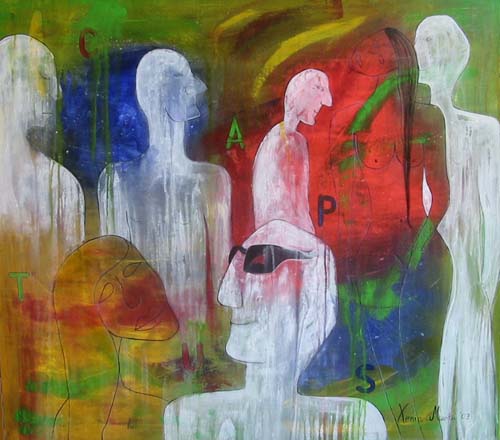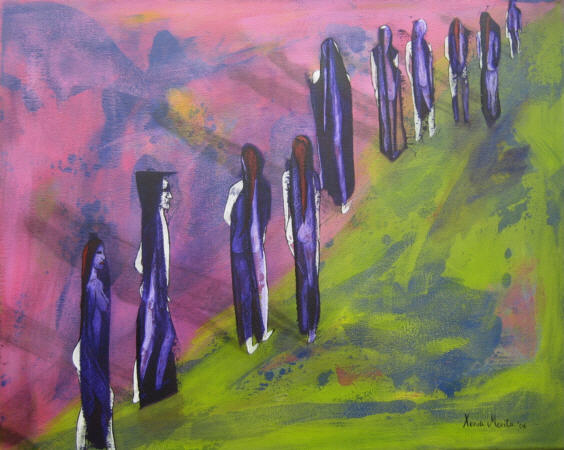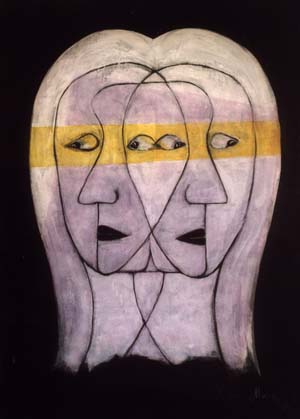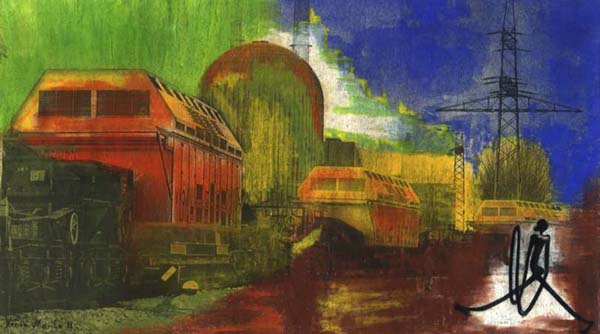White Strangers (Selection) - Gallery - Videos

Captus - Acrylics on canvas 100 x 100cm
„Everyone is a stranger, almost everywhere.“
This is the main subject of this cycle of paintings named "White
Strangers". It's hard being a stranger in in our human society. Mistrust
and social hostility put a strain on the outsider. In addition to that they
often cannot cope with their home sickness their losses and lack of hope.
Their is a great fear of getting emotionally hurt. Men and women express
their strangeness quite differently in these paintings. While deep emotions
are expressed in the women's faces the men seem to be hidden behind a mask
of aloofness and arrogance.
The figures in the paintings are white. This refers to the global context of
the subject. In Central Europe most citizens associate strangers with dark colours
as dark skin, dark eyes and black hair. They mostly are not aware of the fact
that in most parts of the world light-skinned people are the minority, i.e, strangers.
Though the white strangers are identifiable as humans they cannot be assigned
to a specific ethinal group.
The Latin Titles although refer to the feelings of the strangers. View
Gallery...
Borderliner - Gallery

Borderliner II Acrylics and oil on canvas 40 x 50 cm
In 2006 the artist created the "Borderliner" cycle,
a further development of her her famous series "White Strangers" -
dealing with social problems of globalization. Those strangers frozen in
social hostility now gradually start moving. In groups or lines they walk
a tightrope - they actually tread a path on a narrow mountain ridge - symbolizing
the green border between two countries as well as the mental state of many
of those people. Crossing borders, physically and emotionally, as a result
of the unjust diversification and distribution of ressources. While these
well off people brimming over with wealth here lose their inner balance those
people there are crossing borders in order to become part of this prosperous
society. Nowadays mobility has become a crucial aspect to arrange one's life.
Mobility, however, also implies the loss of one's connection to the past.
There is no chance of socialising with others. The results are loneliness
and being uprooted, which again could lead to further frontier crossings.
The
borderliners shown in Xenia's paintings indicate various forms of frontier
crossings, they could be geographical, physical as well as mental, they always
interfere however with the vital need for stability. View
Gallery...

Liv, Lilo, Lida, Lisia - Acrylics on canvas 70 x 50 cm
These paintings are about possible future human cloning and its controversial ethical issues. The artworks are shown in several exhibitions e.g. in Universities and churches. View Gallery...
African Rock Painting and Modern Technology - Gallery

Goetzenanbeter Gouache on paper 19 x 11 cm
There is no doubt today that mankind has its origin in Africa. Thousands
of years ago in the
mountains of the Upper Brandberg stone age hunters painted their images on the
rocks within their caves.Thanks to outstanding scientific research - most of
all by the Heinrich-Barth-Institut
at the University of Cologne - the rock art of the Brandberg is one of the best
studied bodies of pehistoric art in the world.
The Brandberg -located in the semiaride region of the northern Namib- provided
good living conditions for those early inhabitants. Due to its altitude of more
than 2500m and the short distance to the sea there is sufficient rainfall and
there are numerous waterholes that store rainwater for weeks and months after
rain.There are also areas with dense bush and tree vegetation with comparatively
rich wildlife. The caves and rock shelters were quite pleasant places to live
in with moderate temperatures because of the cooling effect of the rock masses
during day time and the storing of heat during the nights.
Most of the rock paintings of the Upper Brandberg are dated to 4000 till 2000
years bp.
These early works of art were painted with great skill and still give reason
for various interpretations. Another remarkable feature of the rock art of this
area is the great number of human figures that are depicted while elsewhere mostly
paintings of animals have been found.
Xenia Marita Riebe made those tender protagonists of rock art the centre of her
artistic creativity. A certain crucial experience in addition to her taking a
particular interest in the
evolution of mankind lead to her working on the subject artistically.
Enthusiastic about those early works of art she travelled to the Brandberg in
Namibia to view the original paintings and meet the descendants of the ancient
Khoisan people, the San.
In her paintings these crucial images are shown passing through various periods
of cultural history.They easily enter ancient temples, prowl around medieval
castles, dance under electric power lines or take a ride on a modern train.
Through her paintings Xenia Marita Riebe wants to point out the estrangement
of modern people from their natural roots. Through all our efforts to get faster,higher
and farther in technology we seem to forget about the essentials of life. By
eclipsing these areas of life and periods of time in her works the artist attempts
to remind us - to make us pause to think.
All the depicted figures are derived from original rock paintings of the Upper
Brandberg. The light of the African savanna, the clear sky and the unique sunsets
above the orange dunes of the Namib desert stimulated the artist to use bright
radiant colours for her paintings.
Painted on newsprint the pictures indicate to one possible function of rock paintings
at that time.
The Khoisan rock artists might have been chroniclers or even journalists who
documented life and tradition of their people or they just reported news.
Through her paintings Xenia Marita Riebe pleads for more tolerance towards ethnic
groups especially towards coloured people. She wants to make people of the northern
hemnisphere
aware of the fact that all human life has its origin in the so-called "dark
continent" thus paving the way for more global thinking and acting. View
Gallery...